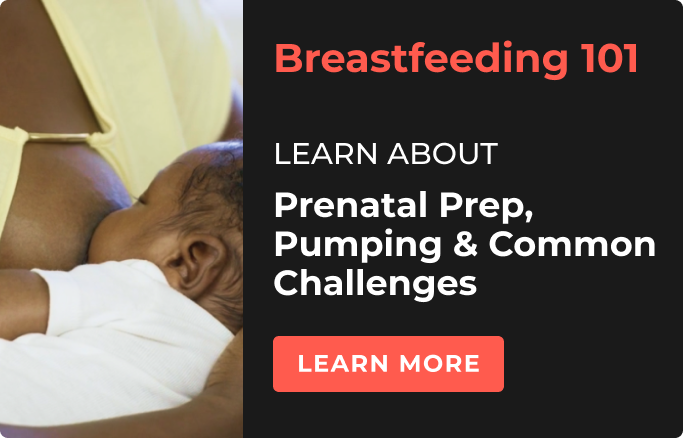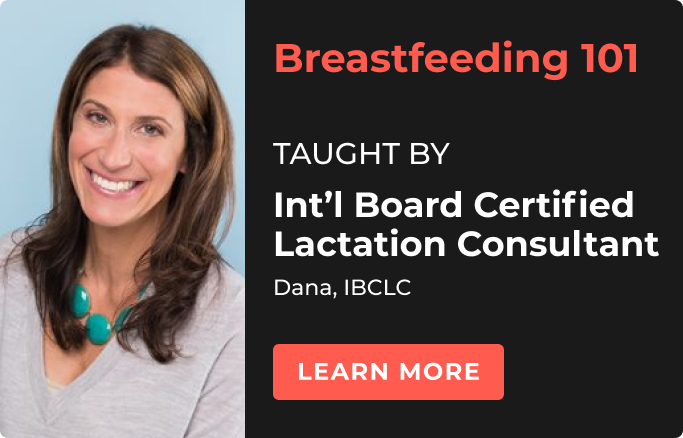One of the most common questions we hear from breastfeeding parents is, “Why can’t I get a good latch?!” Many common feeding challenges, including nipple pain, can be resolved from ensuring a good latch.
We asked our certified lactation expert Dana, to talk about what makes a good latch and how to troubleshoot if you think your baby is having latch issues.
4 ways to know if baby has a good latch:
1. Check baby's positioning.
First thing’s first, make sure that baby is snuggled in tight. Baby wants to feel secure, so if you are using the cradle or cross cradle position, look for baby to be “belly to belly” with you.
Next, make sure baby’s head, neck, and torso are all in a straight line. You don’t want baby to have to turn their head to the side. Turn your head to the side and try to swallow. It’s difficult, right? Well it’s just as difficult for baby, too.
2. Check baby's mouth.
Remember: this is “breast” feeding NOT “nipple” feeding and that’s because baby’s mouth should be covering more than just your nipple. In fact, a significant portion of your areola is likely to be covered (exactly how much depends on your anatomy, of course!). But know that baby will likely not be covering the top and bottom of the areola evenly. Usually, the latch will be “asymmetrical” and cover the bottom of the areola more than the top.
3. Watch baby's lips.
Generally, baby’s lips should be at an angle of 135 degrees or more. If baby’s lips are less than 90 degrees, baby is likely just sucking on the nipple which 1) hurts and 2) isn’t very effective. Also look for lips that are flanged like a fish, not curled inside.
4. Don't disregard your comfort.
Breastfeeding should not hurt! Soreness can be normal during the first few days, but consistent pain is not. If it is painful, try one of our troubleshooting methods below.
What to do if you think baby doesn’t have a good latch:
Change something!
Sometimes a simple adjustment in baby’s positioning can do wonders. For example, in a cradle or cross cradle position, try lifting baby’s tush to help open their jaw. Or try opening their mouth wider by gently placing your index finger on baby’s chin (outside their mouth so not to break the latch) and pulling baby’s mouth/jaw wider. Or you might find you need to switch it up and find a new position altogether. If the football hold has always been your go-to, but isn’t feeling right anymore, try a baby-led latch or cross cradle instead.
Stop & Try Again
Please don’t suffer through a bad latch. If something is really hurting, break the latch and try again. To do that, put your finger in the corner of baby’s mouth and go in-between your nipple and baby’s tongue to break the suction, then push your nipple back towards your chest. Don’t just pull baby’s head back while they are still attached to your nipple. That will hurt!
Wait for the Baby to “Invite” You In
Don’t think about breastfeeding as giving the breast to your baby. Instead, think about it as bringing the baby to you. So don’t just try to stick your nipple directly in baby’s mouth. Instead, line up your nipple with baby’s upper lip and nose, and gently rub your nipple on baby’s upper lip or from baby’s nose down to the upper lip. This should cause baby to open wide and tip their head, which is your cue to guide baby to the breast. If this doesn’t happen immediately, don’t try to force it. Wait for baby to gape and invite you in.
Ask For Help!
If breastfeeding is hurting while you are in the hospital or birth center, ask for help right away. The staff is well trained to support you and your baby, and oftentimes, they have a lactation consultant on staff. Don’t assume pain is normal. The earlier you address a poor latch, the better for you and baby!
If issues arise outside of the hospital or birth center, seek out the guidance of a certified lactation consultant. Your OB and midwife can help with recommendations, but know that Tinyhood also offers 1:1 consultations with a team of experts.
Looking for more breastfeeding advice? Our online course Breastfeeding 101: From Prenatal Prep to Pumping is taught by a leading Certified Lactation Consultant. Watch this course on your own time, and get handy checklists and pro tips to refer back to at any time. You'll learn how to troubleshoot common challenges, how to tell if your baby is getting enough breastmilk, and how to pump / build a milk supply.
About the Author
Dana C. is a professionally trained IBCLC (International Board Certified Lactation Consultant), who has earned the highest credentials one can pursue in lactation consulting and works at a top-ranked hospital where she has helped thousands of families. She is ivy-league educated with a master’s degree in public health, is a mom of two kids (and two dogs), and enjoys tending to her vegetable garden.




